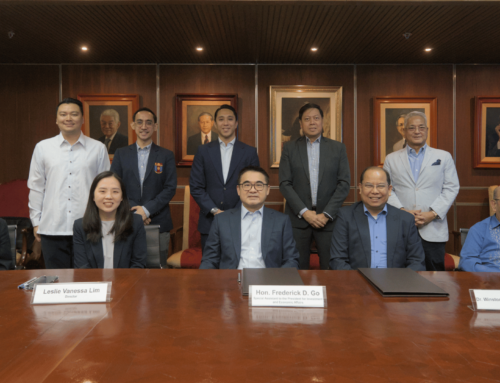This article was originally published on 2019-09-02 15:40:11
As buzzwords in the world of education and human resources go, the phrase ‘T-shaped skills’ is still relatively new. It was first used, rarely, in the 1980s and 1990s, but came into common use among technology companies some time in the early-to-mid 2010s.
But the principle behind it is relatively simple: that the members of today’s workforce are confronted with situations so complex that it isn’t enough to be experts in their specialized areas anymore. They also need to be able to collaborate with experts in other fields, creatively finding applications for their knowledge in disciplines outside of their formal training.
It’s a paradigm that Mr. Rafael ‘Raffy’ Santos, an Media and Information Literacy instructor at the University of Asia and the Pacific’s College of Arts and Sciences, takes seriously – enough so that he’s bringing it up at two conferences later this year – first at the Innovation in Education conference co-hosted by the United Board for Christian Higher Education in Asia (United Board) and Soegijapranata Catholic University (SCU) in Semarang, Indonesia next October; and then atthe 2019 Asian Conference on the Liberal Arts (ACLA) organised by The International Academic Forum (IAFOR), which will be held at Lingnan University (LU) in Hong Kong next November.
Mr. Santos’ paper, “Humanizing T-Shaped Thinkers: A Contextualized Reinvention of Technology and Media Education for Junior College in the Philippines” springs from his experiences while teaching a Junior College class in Media and Information Literacy (MIL) – a course required under the K-12 Basic Education Curriculum which the Philippines’ Department of Education (DepEd) has been implementing since 2011.
“They’re Already Media Literate.” One of the challenges Mr. Santos faced when he first started teaching the class was that he realized that his students, who were supposed to be learning media and information literacy, were already media literate.
“MIL, as required by the DepEd,” he explains, “basically comes from the perspective that the Philippines has to adapt to the digitization and [computerization] taking place around the world. So we have to teach students how to make use of available technology. [That includes] media use, media content, everything. Their framework is what’s called Partnership for 21st Century Skills (P21). The idea behind it is that whatever you’re teaching – be it theology, the humanities, liberal arts, etc – you need to integrate ICT.”
“And that’s where DepEd was coming from when they required MIL,” continues Mr. Santos. “The expectation they have is that teachers should be able to teach the students how to make use of computers, how to use apps, how to produce simple projects like videos and blogs… that’s basically it.”
The moment Mr. Santos looked at the prescribed MIL curriculum and thought about how to teach it to his students, however, he realized that he had a problem. “I realized, specially here in UA&P, that they’re already media literate. So what do you do [as an MIL teacher] if your students are already media and technology literate?”
At first, he coped by giving the students more challenging tasks. He also asked them to ‘unlearn’ and ‘relearn’ things by requiring them to disconnect from new technologies for a while and learning how to make use of traditional media. After all, he says, “media doesn’t only mean modern technology.”
After his first semester teaching the course, however, he started taking a closer look at the ‘Whole Person Pedagogy’ or ‘Whole Person Education’ (WPE) approach which supposedly lies at the foundations of P21, and found ways to apply it from a novel direction. “Maybe it shouldn’t be about teaching these kids how to be media literate when they already are. What about helping them build their other skills as they [work to complete] their required projects?”
The Vertical and the Horizontal Arms of the “T.” The DepEd-prescribed subject matter of the MIL class called for the students to gain a specialized knowledge of ICT. In the metaphor of ‘T-shaped learners,’ that would be the “specialized expertise” which is the vertical arm of the ‘T.’
Following the whole person approach, Mr. Santos wanted to make sure the projects he assigned went beyond the development of ICT skills, which is an example of cognitive learning, and instead also gave the students opportunities for interpersonal and intrapersonal development, which are the two other arms of the WPE framework. In the metaphor of ‘T-shaped learners,’ for interpersonal and intrapersonal learning would constitute the horizontal arm of the ‘T.’
The students would thus be ‘T-shaped learners.’
They would develop the specialized knowledge of ICT required by the DepEd from students who take the MIL course. But since in the case of Mr. Santos’ students, they already had that expertise, their main takeaway from the MIL course would be the way their specialized ICT knowledge connects to the interpersonal and intrapersonal skills they pick up from the projects.
“I came up with ten projects which required the students to make use of CANVAS (UA&P’s online learning management system), and required them to make use of apps and media.” The major project for the semester was for the students to produce a book, which they would have to write, produce, and file for copyright with the National Library. “When they produce the book, they have to develop all three competencies, whether they know it or not. Writing the articles involves problem solving, critical analysis and creativity – that’s all cognitive. And then they have to communicate with others. They collaborate. That’s interpersonal. And then, since the topics assigned to them are social issues, that’s the intrapersonal. And so, in one project, they have to hone their skills in all three domains.”
Based on a survey evaluating the impact of eight of the ten projects, as well as observable improvements in student performance, he was pleased to find that his ‘humanized’ curriculum was very successful.
Intentionality is Key. But Mr. Santos began to understand the significance of his efforts when he started looking for literature about other local schools which applied a Whole Person Education framework to Media and Information Literacy.
He couldn’t find any.
“The hasn’t been much [written about efforts to achieve WPE in MIL classes, even though] the idea of Whole Person Education is pretty much spelled out by the DepEd, and [in the stated mission and vision] of practically every school that I know of. But it’s one thing to say you are pursuing [a Whole Person Education] framework, and it’s another thing to really implement them.”
Mr. Santos notes that difficult circumstances often limit the ability of instructors to implement WPE. “In most cases, instructors face circumstances where they have focus most of their attention on making sure that lessons are taught, that classes are held, and that they perform their professional responsibility as defined.” He then asks, “But is that enough?”
On the other hand, says Mr. Santos, “I’d like to believe that other instructors are doing this in their classes, [just not consciously or systematically]. That’s why [I place an emphasis on] intentionality. And that’s why, in the title of my study, I chose the word ‘humanizing.’ It’s an action word. You humanize [the course]. You repurpose it. Intentionally.”
After expanding his literature search, Mr. Santos did find one case where a university implemented Whole Person Pedagogy, not in one subject, but for all the classes in their engineering department.
“In that case, it was wider, bigger in terms of scope. They added theology, they added writing…. Basically, they added liberal arts into their engineering subjects, both as individual courses and as elements of their whole engineering course. For example, if their students had a course on the Strength of Materials, they would integrate theology, citizenship, and so on.
“When I learned about what they were doing,” Mr. Santos says, “I felt good about [my own work]; their work was [on a macro scale], and mine is the micro version of what they were doing. But the point is, it can be done. That’s why I felt I should work on this paper. I’d like to think UA&P is pioneering [in doing it intentionally] in the area of MIL.”
“Intentionality is the key term – Intentionally integrating the teaching of interpersonal and intrapersonal skills [in the teaching of MIL]. If we really want to produce T-shaped graduates and if we really want to live up to Whole Person Pedagogy, then the answer is intentionality.”
Conclusions, Recommendations, and a filled-up whiteboard. But are Mr. Santos’ findings applicable to the teaching of MIL in other schools? Mr. Santos is the first to acknowledge that the specific experience of UA&P, a private institution, are very different from other institutions, especially Philippine public schools.
“[Schools have to examine their] strengths. If they’re strong in terms of [giving their students] interpersonal and intrapersonal skills, then their application of WPE to the P21 framework would have to focused on cognitive skills regarding the use of ICTs. If they’re strong in P21 already, then they have to focus on the interpersonal and the intrapersonal.”
Mr. Santos’ recommendation was for other schools implementing the MIL course to examine the different ways that they can apply Whole Person Education to their classes. That, he says, would be a basis for reexamining the MIL class on a national scale – as applied by DepEd in their whole K-12 program.
He acknowledges that his study tries to address the issue in a very specific, “very micro” way. But that doesn’t stop him from being passionate about his study.
By the time CRC’s interview with Mr. Santos had finished, he had filled the meeting room’s whiteboard with notes on the WPE framework. During the interview, he had asked — somewhat sheepishly — whether it was okay for him to write on the board.
But there was nothing sheepish or apologetic about the reason he gave for wanting to write on the whiteboard. “You see,” he says, firmly and with pride. “I’m a teacher.”
———————————————
The Center for Research and Communication is a research and consultancy group that partners with the University of Asia and the Pacific (UA&P), drawing upon UA&P’s considerable human and knowledge resources to meet the research needs of businesses and development agencies throughout the Philippines. To find out more about CRC’s work and its various researchers and consultants, you can contact Communications Officer for Research, Mr. Remi de Leon, by email at [email protected].






